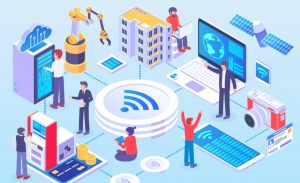In these hard summer times in Delhi, my 10 years old asked me as to why his room could not be at the desired temperature upon his return from school. Easy sunny, would switch the Air-conditioner on remotely every day, I was quick to suggest. Knowing well, once at the office with I would forget about the promise, he wanted me to implement an automation solution.
We are living in a fast-paced India and the generation next is expecting beyond the basics. This is not just a domestic perspective but an industrial one too. Efficiency and precision are two buzz words that constitute the backbone of any organizational objective. The nation has graduated from the age of the postcards to instant messaging and now with the advent of 5G, we are preparing to live in an always-connected real-time world. Technology adoption for the new age India is imperative.
 As we digitize our systems and automate them, one tech solution that helps optimize and constantly improve the return on every invested rupee is, IoT or the Internet of Things. To me, simplistically this is an automatic feedback mechanism that constantly helps improve the efficiency of the produce. It has four key parts, namely Information collection that happens via the sensors, Information transmission mediums/ technologies like LORA, 5G etc, the Information Management and Control Software and the Application or the Outcome. IoT as a technology has three cases of its adoption, namely Consumer IoT – like connected appliances, smart cars, phones, etc. , Commercial IoT – Smart Building, Asset tracking, location-based services, etc., Industrial IoT – Waste Water Systems, Robotic for Manufacturing, the system of connected industrial devices & systems.
As we digitize our systems and automate them, one tech solution that helps optimize and constantly improve the return on every invested rupee is, IoT or the Internet of Things. To me, simplistically this is an automatic feedback mechanism that constantly helps improve the efficiency of the produce. It has four key parts, namely Information collection that happens via the sensors, Information transmission mediums/ technologies like LORA, 5G etc, the Information Management and Control Software and the Application or the Outcome. IoT as a technology has three cases of its adoption, namely Consumer IoT – like connected appliances, smart cars, phones, etc. , Commercial IoT – Smart Building, Asset tracking, location-based services, etc., Industrial IoT – Waste Water Systems, Robotic for Manufacturing, the system of connected industrial devices & systems.
While the importance of the technology is well understood and appreciated by the leaders, its development and adoption are at an early stage in the country. Our optimism with respect to adoption of IoT can be clearly understood from the push that the government has for, Digital India & Smart City projects, another driver is the Make in India that is helping new industries to be set up on the industrial 4.0 format. These projects have some of the latest applications of IoT being deployed right from a smart pole to service street light and communication requirements, management of waste and its disposal, remote doctor monitoring applications and intelligent parking to name a few. There are currently 7.7bn people on earth, of these 4.4bn, have access to the internet. Asia contributes 50% of the internet users, with India accounting for more than 25% at 560Mn users as per the Internet World Stats website. A report from NASSCOM projects that by the year 2020 we shall have an IoT device base of 1.9bn units and market size of USD 9bn. The report outlines that the Manufacturing and Automotive verticals will experience maximum adoption of IoT, whereas Transportation and Logistics will provide maximum IoT revenue by the year 2020.
Adoption of IoT in the automotive, home and logistics sector is starting to take off but the Industrial IoT  deployments have been very slow. As we know, industrial automation has been very nonstandard with the use of SCADA, PLC’s of varying degree while others have literally all mechanical working. These systems would not change fast; there is also a human angle that will resist any change on the shop floor. Yet at the same time deploying a full overlay network of sensors may not be practically viable from both deployment complexity and cost. Given the uniqueness of the machine OEMs and their deployment a combination of solutions may be required in certain cases, that then need to be integrated for best results.
deployments have been very slow. As we know, industrial automation has been very nonstandard with the use of SCADA, PLC’s of varying degree while others have literally all mechanical working. These systems would not change fast; there is also a human angle that will resist any change on the shop floor. Yet at the same time deploying a full overlay network of sensors may not be practically viable from both deployment complexity and cost. Given the uniqueness of the machine OEMs and their deployment a combination of solutions may be required in certain cases, that then need to be integrated for best results.
Our society has a variety of expectations from the connected world, like a connected smart refrigerator that can order based on the requirements on its own, to improvements in the health care system of the country. IoT is expected to bring in a new order to our society with not just our work but our living itself. However, there are certain challenges that need to be addressed to ensure quick adoption of the technology systems.
- Digitization of information and processes in the industry is ongoing and will take some time until we are fully ready. There has been a significant push by the government under its Digital India Program for the initiative. However, we continue to use old machinery that lacks the capability to generate enough measurable information; this makes the task more complicated.
- Investment in the innovation of IoT based products and solution. It is observed that while we have great capabilities but lack funds to grow in scale and device zero defect solutions. The investment environment in the country is improving and it is expected that in the near future we shall see more and more world-class internet products being developed in the country.
- Network security of IoT solutions. As per a recent article by News 18, cyber-attacks on IoT deployment in the country increased by 22% over the last quarter. Smart Cities, financial services and transportation led the sectoral ranking in terms of the attacks. Data security is hence a paramount concern for enterprises. More endpoint connected devices mean more data risk and hackers can tear down an enterprise’s operations. Approaches like security by design will have to be adopted in the country to overcome such issues. In another case, where ever possible the IoT devices can be installed over a dedicated network with no connectivity to the internet.
- Proven Business Case and RoI. There is a certain level of hesitation amongst enterprises towards investments in IoT solution wrt its RoI. This is, however, being overcome by close coordination between the solution provider and the customer and explaining the tangible and intangible benefits of the IoT solution being offered. Models like pay per use and solution leasing can be adopted to provide the requisite promise.
- Standardization and compatibility. Different IoT technologies are taking different growth routes in the absence of any standardization. Further, there are no standard M2M protocols, nor are there unified cloud services, an absence of standardized firmware or OS that is being in the IoT devices. In the absence of any standardization, there is a risk to the longevity of a solution deployed by an enterprise.
- Lack of trained /experienced IoT professionals. As the demand for IoT uptake increases, we do not have enough trained resources. The connected IoT devices have grown many folds and its number is multiplying monthly. We do not have enough Big data Pros or Quality cybersecurity experts. The availability of quality technocrats with core IT experience in device integration and application development is also short.
As per Deloitte Analysis, there are about 120 IoT organizations in India and about 60% of these are startups. These are positive indicators of growth, supported by government initiatives of Digital India and the 100 Smart Cities push. As a nation, we have shown the willingness to accept technology and its solutions that have added comfort and efficiency to our life. I am confident that the coming generations will accept and adopt technology faster and better & soon enough my son may just be creating the next AI Robot to assist me on my world tour.



